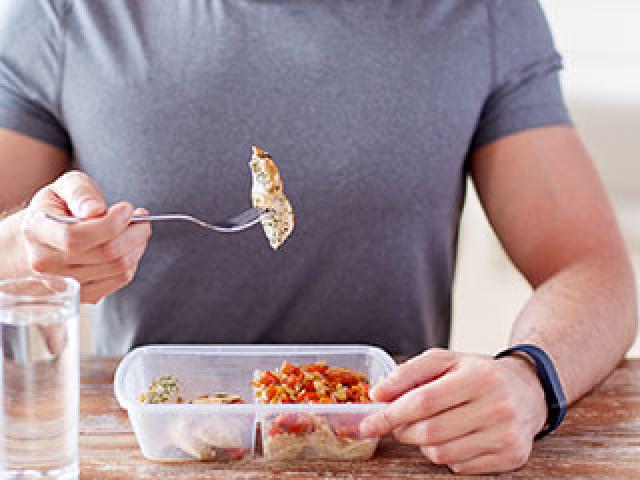The 'Five and Two' Eating Plan

When we think of diet, we typically think of weight loss. However, we need to use the word ‘diet’ to describe the type of food and drink we consume to stay healthy.
A diet should be something you can follow for a long period of time. If it is something you only do for a few weeks, such as drinking your meals or eating the same food three times a day, it is probably not a diet that can easily be followed for any length of time. Secondly, there are no specific diets for specific ailments. Don’t be confused by a diet that promotes help for arthritis, diabetes, heart disease, or Alzheimer’s, for instance. A good, healthy diet should be exactly that – a diet that promotes overall health for all health ailments.
Take More Steps Forward
Getting healthy or losing weight is all about taking more steps forward than backward. The more healthy meals vs. unhealthy meals you eat, the faster you will reach your desired goal. This is why I recommend the Five and Two Eating Plan. The concept is simple – treat your body like a temple for five days, and then treat it like an amusement park (eating sweets, cookies, candies, desserts, junk food) for two.
For five days eat a healthy, nutritious diet. If you need to take a break and reward yourself for five days of good eating, go ahead and eat less healthily on two days. The goal is to have more good eating days than bad. If we eat well for five days and poorly for two days, at least we take more steps in the right direction. Of course, it would be better to take seven steps in the right direction with our dieting plan, but that may be too much to ask.
When people do a good job of dieting for five days, they often look forward to rewarding themselves with something sinfully delicious on those two other days. However, many times they may eat only a couple of bad meals over the weekend, instead of six terrible meals. When people start applying the Five and Two Eating Plan, they start noticing differences, they start seeing results. This is a motivator and frequently leads them to follow a “six and one eating plan,” which is fine, because I know there will be other times they follow a “four and three plan.”
Here’s an important point – you should earn those “amusement park” days. Don’t go to the ‘amusement park’ every day. You need to earn that right by eating healthily throughout the week.
The Basics
In To Burn or Not to Burn – Fat is the Question, I speak a lot about what truly regulates our metabolism… hormones! Some hormones tell the body to burn fats; some hormones tell the body to store fats; and others tell the body to burn carbs and lean muscle. It’s not just how many calories you eat and burn – it’s triggering your body to burn FAT that counts.
The primary hormones that control our metabolism are insulin, glucagon, cortisol, and adrenaline, which are all produced as a result of stress and diet. Here are some of the effects that stress and diet have:
- Too many carbs (especially refined, processed carbs found in breads, bagel, and muffins, including high fructose corn syrup and maltodextrin) in the diet causes the body to produce more insulin, which tells the body to store fat.
- Protein causes the body to produce more glucagon, which helps the body burn fats.
- Stress causes the body to produce more cortisol and adrenaline, which triggers the body to burn more carbs and protein.
Note: Stress is anything that causes the adrenal glands to produce more cortisol and adrenaline. This includes mental stress, exercise, skipping meals, struggling with digestive issues, and being on the go all day long.
Insulin and glucagon are primarily controlled by diet, whereas cortisol and adrenaline are primarily controlled by stress. However, constant stress (additional cortisol and adrenaline) causes the body to produce more insulin. Indigestion, heartburn, skipping meals, or eating the wrong foods will cause your adrenal glands to produce more cortisol and adrenaline. It is truly a vicious cycle, which is why diet and stress have such a connection to weight loss and overall health.
The Diet Connection
There are Ten Steps for Healthy Eating I recommend if you want to get healthy, stay healthy, or lose those unwanted inches.
Step One – Regulate your blood sugar with the proper balance of insulin and glucagon.
- Eat good protein and fats with each meal.
- Protein and fat slow the release of insulin and allow glucagon to be produced.
- Protein-rich foods are found in eggs, chicken, seafood, beef, pork, lamb, and wild game.
- The availability of glucagon promotes the break down of fats.
- Good fats to eat are the monounsaturated fats (omega-3 and omega-6).
- Good fats are found in coldwater fish (salmon, mackerel, halibut, cod, and sardines), nuts and seeds and various oils (olive, flax, canola, sesame, safflower, evening primrose, and cod liver oil).
Step Two – Reduce or eliminate refined white flour, white sugar, and white milk.
- Learn how fast foods convert to blood sugar by reviewing the Glycemic Index. Stay away from foods made with ‘high fructose corn syrup’ or ‘maltodextrins,’ which are used in most soft drinks, fruit juices, and packaged foods.
- Foods that are made with processed flours and sugars trigger a larger release of insulin and throw your blood sugar further out of balance.
- Most prepackaged food is highly refined. Stay away from processed or refined foods that come in a box or are wrapped in plastic.
- Unrefined foods, like 100% whole grain, should replace foods that are made with highly refined white flour and sugar.
- Milk is a good thing if you get it directly from the cow. Unfortunately, most of the dairy products we consume are highly processed and pasteurized, which means most of the nutritional value has been eliminated.
Step Three – Eat a diet rich in fiber.
- Constipation is a common problem that no one wants to talk about. But it causes internal pollution from the inside of the body.
- Fiber is what the body uses to transport toxins out of the body. If you are constipated, many of the toxins stay inside the body and are reabsorbed back into your system.
- Eat a raw salad a day.
- Eat 5-7 servings of fruits, vegetables, and whole grains.
Step Four – Nuts, seeds, and fruits make excellent snacks.
- Almonds, pecans, walnuts, macadamia nuts, cashews, sunflower seeds, and flax seeds are a great source of omega 3 and omega- 6 fatty acids.
- Nuts and seeds can easily be added to cereal, oatmeal, and yogurt to help slow down the release of sugar and insulin from a meal loaded with carbohydrates.
- Fruits are better to eat by themselves.
- Many people are sensitive to peanuts. Stay away from peanuts if you suspect candida or fungal yeast overgrowth.
Step Five – Avoid partially hydrogenated (trans) fats, artificial sweeteners, and preservatives.
- Partially hydrogenated fats are found in many baked and prepackaged foods. They have been chemically altered from their natural state and are more difficult for the body to process.
- Margarine is a partially hydrogenated fat. Butter is better.
- Artificial sweeteners have not shown any proof that they contribute to weight loss, and research shows them to be associated with many serious health ailments.
- Artificial preservatives, colors, dyes, and flavoring in foods are chemicals that we are ingesting and contribute to chemical stress.
Step Six – Drink only a few ounces (2-6 ounces) of water with your meal.
- The body produces enzymes to digest and break down food. When we ingest large amounts of fluids with our meals (water, tea, soda, coffee, or juices), we dilute the concentration and effectiveness of these enzymes.
- Bloating, gas, heartburn, indigestion, or reflux could be caused by excessive fluid in your meal.
- Drink 8-10 glasses of water each day… just don’t drink a lot with your meal.
Step Seven – Eat as much organic and unrefined food as possible.
- We have eaten organic foods since the Garden of Eden.
- Foods loaded with antibiotics, insecticides, pesticides, and other harsh chemicals are taxing to the liver and kidney and toxic to the brain.
- Refined, processed foods have had most of their vitamins, minerals, fiber, and antioxidants removed. This allows longer shelf life for the manufacturer, but the food is void of any nutritional value.
Step Eight – Combine your foods properly.
- Certain foods combine better than other foods. Proper food combining can eliminate indigestion, bloating, gas, and heartburn.
- Proteins do not combine well with starchy carbohydrates (potato, corn, rice, beans, breads). This does not mean they cannot be eaten together, only that it is more difficult to digest.
- Proteins combine well with fibrous vegetables (broccoli, spinach, asparagus, squash, zucchini, and other green leafy vegetables).
- Eat fruits by themselves.
Step Nine – Don’t ruin a healthy, nutritious meal with a bad dessert or a food allergen.
- You are what your body absorbs! Don’t assume that if you ate it, your body absorbed it.
- Hidden food allergies are common and need to be eliminated for a minimum of two weeks. The common allergens are dairy, wheat, corn, soy, coffee, peanuts, and artificial sweeteners. Eliminate ALL of these for a minimum of two weeks to see if you notice any difference. If you only eliminate one, it is a complete waste of time!
- Bloating, gas, indigestion, and heartburn are associated with hidden food allergens, poor food combining, and lack of digestive enzymes and hydrochloric acid (HCL).
- The absorption of a nutritious, healthy meal can be hampered by the addition of a food allergen or dessert that is loaded with refined sugars, chemicals, sweeteners, flavors, and dyes.
- If you want to have a dessert, wait at least an hour and eat it by itself, or splurge on your amusement park day. Eating a small amount of an unhealthy or allergen food can ruin the absorption of a healthy meal.
Step Ten – Relax and enjoy your meal.
- Eating on the run, in a hurry, or standing up hinders absorption and can inhibit the production of digestive enzymes and hydrochloric acid (HCL), which can lead to bloating, gas, indigestion, and heartburn.
- When you are always eating on the run, in that “fight or flight” mode, your body will not produce very much HCL, which is needed to digest protein. Much of the digestive problems occur because of a lack of HCL – NOT too much as commercials would like us to believe.
- Take the time to enjoy your meal and properly digest your food!
Good digestion is critical in the healing process. A healthy meal is how we nourish the body. We can not expect our bodies to overcome any health complaint if we cannot absorb the nutrients in our diet and supplements. If digestive issues are a common problem, I can assure you that you are NOT absorbing the nutrients from your diet.
Let me suggest the online Health Quizzes to see if digestion could be affecting your health. In which case, I would recommend using the Healthy Steps Program. It will literally walk you through the healing process and repair your digestive system, which will improve your overall health. Give it a try for 30 days and see if it doesn’t begin to turn your health around.





